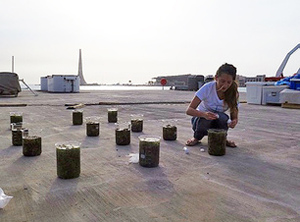1.2.17 | Congratulations to Anny Cardenas, who received the highest grade for her doctoral thesis. In the frame of her research she travelled to Saudi Arabia to investigate the impact of marine pollution on coral reefs and associated microorganisms.
Polluation of coastal waters is increasing oin a global scale resulting in frequent algal blooms and high concentrations of dissolved organic carbon (DOC). Doc particlaes are smaller than 0,45 μm and can be easily broken down and used by bacteria. Some sugar molecules in particular are causing bacteria to thrive.
In coral reefs bacteria are playing an important role in guiding coral larvae to settle. But what will happen to bacterial communities if levels of dissolved organic carbon in the water are too high? This is what Anny Cardenas wanted to find out during her fieldwork in Saudi Arabia and in a series of experiments at the ZMT’s marine experimental facility.
“I found that the composition of different types of bacteria changes noticeably,” says Anny Cardenas. “Pathogenic types took over, which carry many virulence factor in their genome. It is assumed that these opportunistic species can be damaging to the corals.” Meanwhile other species, which are of benefit to the corals, disappeared as Cardenas observed.
The young scientist used metagenome and metatranscriptom analyses to gain insights into the metabolic capabilities of the microorganisms. Thus she could find out that the metabolism of some of the examined species changed: harmless metabolites turned into poison.
“An added factor can come into play to make the problem worse,” reports Cardenas. “ Ocean acidification also has an influence on the water chemistry: the level of dissolved organic carbon increases which further changed the bacterial communities.”





